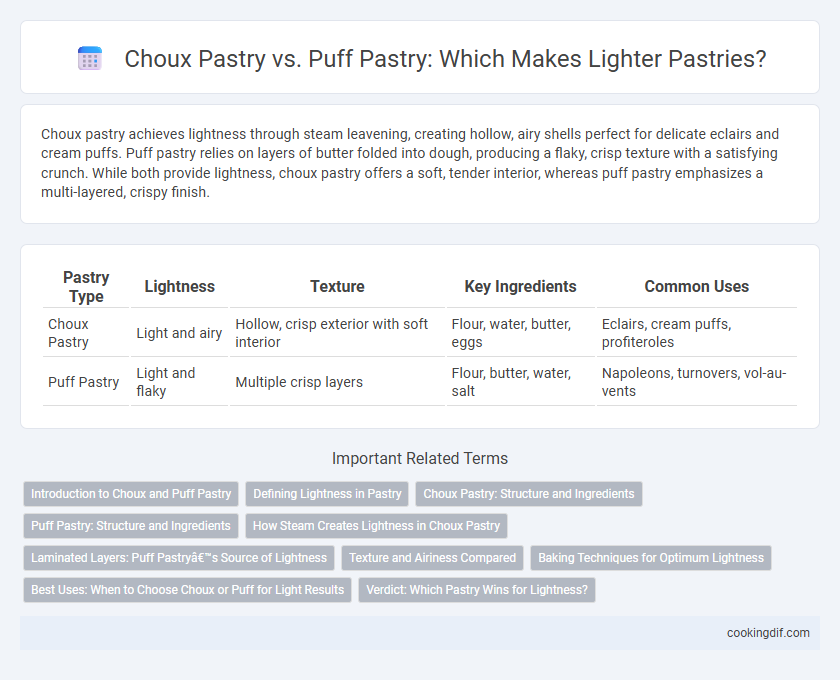Choux pastry achieves lightness through steam leavening, creating hollow, airy shells perfect for delicate eclairs and cream puffs. Puff pastry relies on layers of butter folded into dough, producing a flaky, crisp texture with a satisfying crunch. While both provide lightness, choux pastry offers a soft, tender interior, whereas puff pastry emphasizes a multi-layered, crispy finish.
Table of Comparison
| Pastry Type | Lightness | Texture | Key Ingredients | Common Uses |
|---|---|---|---|---|
| Choux Pastry | Light and airy | Hollow, crisp exterior with soft interior | Flour, water, butter, eggs | Eclairs, cream puffs, profiteroles |
| Puff Pastry | Light and flaky | Multiple crisp layers | Flour, butter, water, salt | Napoleons, turnovers, vol-au-vents |
Introduction to Choux and Puff Pastry
Choux pastry, made from a simple dough of butter, water, flour, and eggs, puffs up during baking due to steam, creating a hollow and airy interior ideal for cream-filled desserts. Puff pastry consists of multiple layers of butter and dough folded repeatedly, producing a flaky, crisp texture through the separation of layers as it bakes. Both pastries offer lightness, but choux achieves it through steam expansion, while puff pastry relies on laminated layers.
Defining Lightness in Pastry
Lightness in pastry often refers to the airy texture and delicate crumb structure achieved through steam leavening and fat incorporation. Choux pastry relies on high moisture content that generates steam, creating hollow, crisp shells ideal for eclairs and profiteroles. Puff pastry attains lightness by layering butter and dough, producing multiple thin, flaky layers that rise and separate during baking for a tender, crisp finish.
Choux Pastry: Structure and Ingredients
Choux pastry achieves its characteristic lightness through a high moisture content that creates steam during baking, causing the dough to puff and form a hollow, airy structure. Its simple ingredients--water, butter, flour, and eggs--combine to create a delicate balance where eggs provide both moisture and structure, essential for the pastry's rise and light texture. Unlike puff pastry, which relies on layers of butter and dough, choux pastry's unique steam leavening method results in a crisp, tender shell perfect for cream-filled pastries.
Puff Pastry: Structure and Ingredients
Puff pastry achieves exceptional lightness through its unique structure of numerous thin, alternating layers of dough and butter, created by repeated folding and rolling. The high-fat content, primarily butter, melts during baking, producing steam that causes the dough layers to separate and rise dramatically. In contrast to choux pastry, which relies on high moisture content and eggs for expansion, puff pastry's lamination process results in a crisp, flaky texture ideal for delicate, airy pastries.
How Steam Creates Lightness in Choux Pastry
Steam plays a crucial role in creating lightness in choux pastry by causing the dough to rapidly expand during baking, resulting in hollow, airy shells. Unlike puff pastry, which relies on layers of butter and dough to achieve flakiness, choux pastry uses high moisture content to generate steam that inflates the dough. This steam-driven expansion produces the characteristic light, crisp texture unique to choux pastry.
Laminated Layers: Puff Pastry’s Source of Lightness
Puff pastry's lightness is primarily due to its multiple laminated layers created by folding butter into the dough repeatedly, which produces steam during baking and causes the dough to rise dramatically. In contrast, choux pastry relies on steam generated from high moisture content within the dough, resulting in a hollow and airy interior but without the distinct flaky layers. The laminated technique in puff pastry ensures a crisp texture and delicate flakiness unmatched by the soft, pillowy structure of choux pastry.
Texture and Airiness Compared
Choux pastry features a unique airy texture achieved through steam-leavening, resulting in hollow, delicate shells perfect for cream-filled pastries. Puff pastry relies on numerous thin, flaky layers created by folding and butter layering, providing a crispy, light bite but denser than choux. The airiness in choux comes from internal steam expansion during baking, while puff pastry's lift is mechanical, making choux generally lighter and more ethereal in texture.
Baking Techniques for Optimum Lightness
Choux pastry achieves lightness through high moisture content that creates steam during baking, causing the dough to puff and form hollow centers ideal for eclairs and cream puffs. Puff pastry relies on meticulously folding and layering butter between dough sheets, creating hundreds of thin layers that separate and rise into a flaky, airy texture. Mastering temperature control and precise lamination techniques is essential for both pastries to maximize their characteristic lightness and delicate crumb structure.
Best Uses: When to Choose Choux or Puff for Light Results
Choux pastry creates airy, hollow shells ideal for cream puffs and eclairs, leveraging steam for lightness and structure. Puff pastry's multiple layers result in crisp, flaky textures perfectly suited for delicate tarts and savory appetizers. Choose choux for soft, light interiors and puff for crisp, flaky lightness in your pastries.
Verdict: Which Pastry Wins for Lightness?
Choux pastry is lighter and airier than puff pastry due to its high moisture content that creates steam, causing it to puff up dramatically during baking. Puff pastry relies on layers of butter and dough to create flakiness, resulting in a denser texture despite its crispiness. For unmatched lightness, choux pastry wins as it produces delicate, hollow shells perfect for airy desserts like eclairs and cream puffs.
Choux pastry vs Puff pastry for lightness Infographic

 cookingdif.com
cookingdif.com